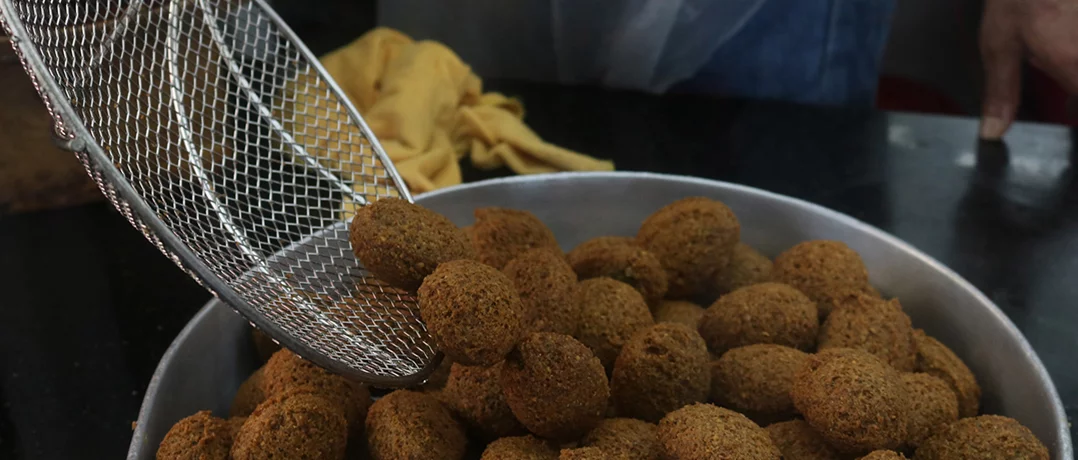A city in every bite
A city in every bite


Across Lebanon, street food is more than sustenance. It is a living archive.
Every city tells its own story through what is sold from peddler carts, wrapped in paper, and eaten on the move. These dishes map the contours of daily life: economic shifts, migrations, and the pulse of public space. In a country where tradition and modernity often collide, street food remains one of the most enduring expressions of belonging.
In Lebanon, food is tied to the rhythm of the street. Where food is not plated, it is passed from hand to hand, warm, wrapped, and eaten in motion.
Kamal Mouzawak, a Lebanese food activist and founder of Souk El Tayeb social enterprise promoting and preserving culinary traditions, explained that street food is deeply rooted in the Lebanese culture of commerce and social life.
“Street food is city food. And in our part of the world, it’s medina food, food of the souk, of the old urban heart,” he pointed out.
He also says that the vitality of street food depends not just on the food itself but on the movement around it. When a city loses its heartbeat – its market, its gathering places – food shifts to wherever people still walk, pause, and hunger.
The corn cart in Beirut or the kaake in Tripoli are more than a snack stand. It is proof that Lebanon’s cities haven’t stopped moving.
 From steaming kaak stalls and bustling falafel shops to humble corn vendors, Lebanon’s street food maps out a landscape of memory, endurance, and subtle defiance. Photo: Rayanne Tawil
From steaming kaak stalls and bustling falafel shops to humble corn vendors, Lebanon’s street food maps out a landscape of memory, endurance, and subtle defiance. Photo: Rayanne Tawil
Sliced, stuffed, buttered and grilled
Tripoli has resisted the full erosion of time through its smells and sounds: the clang of metal carts, the hiss of cheese on hot grills, the familiar crackle of kaake (a traditional Lebanese sesame bread) splitting open to reveal its molten core.
Kaake Trabelsiyeh (Tripolitan Kaake) is a round bread filled with Akkawi cheese and brushed with butter before grilling; it is more than a snack; it is a street icon.
“Kaake in Tripoli is special,” says Abu Ahmad, leaning over his cart in al-Nour Square. “We put Akkawi cheese in it, sometimes Picon, with sumac. The shape, the ingredients … It is different from anywhere else,” he added.
Unlike its thinner cousin in Beirut, the Tripolitan kaake is sliced, stuffed, buttered, and grilled until crisp. It is hearty enough to be a meal.
We put Akkawi cheese in it, sometimes Picon, with sumac. The shape, the ingredients… It is different from anywhere else
“It’s filling,” says Barbara Massaad, a cookbook author who explores food’s role in Lebanese identity and community. “Like the mankoushe used to be, food that everyone could afford. That’s changed. Even kaake isn’t cheap anymore. Akkawi is expensive. Electricity, gas … everything.”
Still, the kaake remains fiercely local for Tripoli. Vendors might buy the bread from the same forn (bakery) for decades, adding cheese and extras (tomatoes, olives, green peppers) to order.
Sometimes, sweets are folded into the dough. “We also have Maajouka bi Jebneh,” says Mohamad Dabousi.“It is a very old Tripolitan dish made of Baladi cheese, animal fat, and sugar.”
Dabousi’s main trade, however, is moghrabiyeh. His family has been selling it since 1930.
The Tripoli version of moghrabiyeh is fried, not steamed, and served as a sandwich, not a side dish. “My great-grandfather tried the Moroccan moghrabiyeh and innovated on it. Here we fry it with chickpeas, animal fat, and onions. In Beirut, they do it differently: they add chicken or rice. But this one? It’s ours.”

A corn cart on Beirut's corniche. Photo: Rayanne Tawil
Balcony over the Mediterranean
If Tripoli’s Street food is dense and rooted, Beirut’s is light and entertaining. You don’t eat on the Beirut Corniche to be full. You eat to be part of something: the sea breeze, the laughter, the echo of bicycle wheels turning on pavement.
“The corn carts are an old culture,” says Assad, who sells grilled corn and foul from a cart by the sea in Manara. “Wherever you go on the Corniche, you’ll find us. It’s the people’s dish: kids, families, everyone loves it.”
Corn is boiled or grilled until smoky, chopped on a plastic plate, and eaten as you walk. Unlike the more elaborate dishes of the northern or southern cities, corn on the Corniche is casual, intimate, and slow. It belongs to the long strolls, the unhurried afternoons, the post-dinner walks that define Beirut's rhythm in summer.
For Mouzawak, the rhythm is architectural. “The corniche,” he says, “it’s the balcony of the city.” While cities like Saida, and Tripoli still gather in their souk, Beirut’s communal life shifted seaward.
Even as the number of carts has dwindled due to government restrictions, the ritual survives.
“It was beautiful during the Thawra (the 2019 popular uprising),” recalls Massaad. “People came from all over Lebanon with traditional carts. You’d see corn, coffee, and juice. It was a moment where we reclaimed the street. Now, sadly, many of these carts have disappeared.”
Yet something endures in this simple exchange. A small plate, a burst of charcoal flavor, the sea at your side. “This tradition has been going on long before I was born,” Assad says. “It’s loved by everyone.”
Falafel as language
If Beirut’s food is fragmented and Tripoli’s is anchored, Saida offers a third rhythm: continuity.
On a busy street near the old souk, the smell of cumin and frying oil floats through the morning air. Here, falafel isn’t just food. It’s a habit, routine, comfort.
Abu Rami’s falafel has been open since 1988, but the recipe dates back over 70 years. “My father started young,” says his son Rami. “He learned from his uncles, worked with them for 30 years, then opened his shop.” The falafel itself is thick, golden, and generous. “It’s delicious and cheap,” Rami says. “Simple, vegetarian – loved everywhere. Even globally. Speak to the vendor. Photograph them. There’s nothing like it. It’s nostalgic
What makes it special is its modesty: a sandwich stuffed with falafel, parsley, tomatoes, kale, cucumber, and tahini, nothing more. But it’s also the experience – the smell, the pace, the familiarity. “The flavor hasn’t changed,” says Barbara. “It’s generous. You sit, you eat, you talk. It’s open to everyone. That’s the beauty.”
Saida’s falafel carries a closeness to Palestine, Rami notes. “I believe falafel is originally Palestinian. And we’re close – food culture flows between us.” Here, there is no reinvention – just preservation. “We open at 7:30 in the morning,” Rami says. “We close at 8. Same as always.”
What we eat, we remember
Street food in Lebanon is not always born in the Lebanese land, because the Lebanese have always traveled the world. The moghrabiyeh came from Morocco, falafel from Egypt or Palestine, kaake from Ottoman flour routes. But what makes them Lebanese is not their birth, but their belonging. The way they’re carried through city streets. The way they’re folded into bread, grilled over coal, passed from hand to hand.
“These dishes reflect place and time,” says Kamal. “Tripoli is a port, rich in spices, open to exchange. That’s why moughrabiyeh became what it is. It came here, and we made it ours.”
While some dishes have gone upscale, others remain defiantly simple.
“There’s a shop in France now doing kaake,” Kamal points out. “There are kaake boutiques in Beirut. But for me, the real tradition is alive only if it evolves without forgetting where it came from.”
But with rising costs, changing tastes, and growing fears around hygiene, many of these traditions may fade away.
“My generation loved street food,” says Massaad. “But younger people think twice. They’re afraid of [lack of] cleanliness. They don’t have time to sit for an hour and eat foul.” Still, she encourages them. “Speak to the vendor. Photograph them. There’s nothing like it. It’s nostalgic.”


.webp)